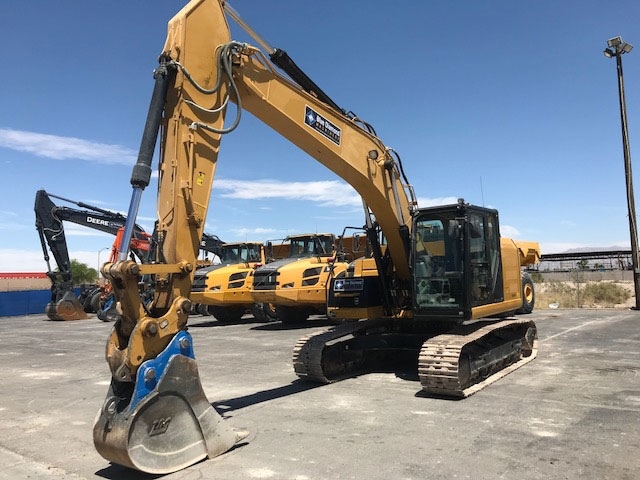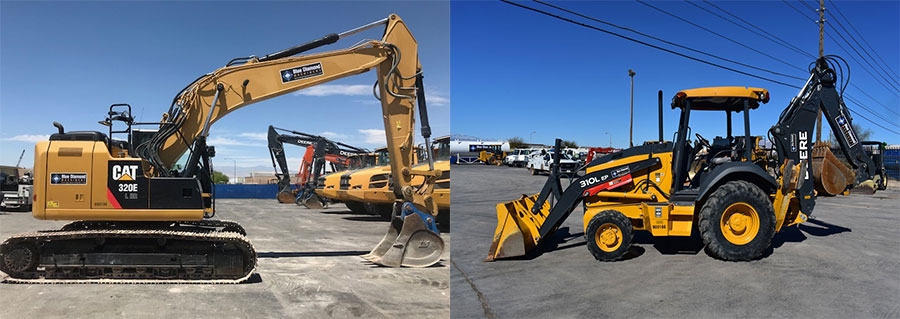Everything You Need To Know about Types of Excavators
This blog contains information about different topics that could be useful for mechanical, electrical and electronic professionals. We look forward to contributing to the expansion of your technical knowledge.

Whether you're planning on renting or purchasing an excavator, it's important that you go into the shopping process with an understanding of the various types of excavators, their capabilities and their shortcomings.
Excavators are earthmoving vehicles easily identifiable by their arm, bucket, rotating cab and moveable tracks. The biggest differentiating factor between the various models is their size, as size often correlates with range of mobility and lift and dig capacity. Caterpillar's smallest mini-excavator, for instance, weighs just 2,070 pounds and has 13 hp whereas their largest is the CAT 6090, which weighs a record-breaking 2,160,501 pounds and has 4,500 hp.
The type of excavator you'll need will vary depending on the working conditions and requirements of the job. Will you be needing to dig in the ocean? A dragline excavator or long reach excavator may be your best choice. Will you be working on hilly terrain? Then your best choice may be a crawler.
Below we outline seven different types of excavators and their various uses.
1. Crawler Excavators

Use for: Mining, landscape grading and trench digging.
Pros: Good for uneven terrain.
Cons: It's slower than a wheeled excavator.
The crawler excavator (also referred to as the standard excavator) is called a crawler because it runs on two rotating tracks instead of wheels—in much the same way a tank does. The crawler uses hydraulic power and although it's slower than a wheeled excavator, its tracked chassis makes it more stable. This is what makes the crawler excavator a good choice for steep, rough or muddy landscapes—The chain wheel system allows it to balance better on uneven terrain.
2. Wheeled Excavators

Use for: Jobs on flat/hard surfaces.
Pros: It's fast and easy to move on concrete.
Cons: It won't work well in muddy or hilly terrain.
The wheeled excavator is like the crawler (standard) excavator, but, like the name suggests, it has wheels instead of tracks. Because the wheeled excavator has less traction than the standard, it's best used on asphalt or concrete.
While the wheeled excavator is not suited for sites with soft soil or hills and slopes, it's faster than a crawler when operated on a smooth, hard surface. It's also easier to maneuver.
3. Suction Excavators

Use for: Fragile digging jobs, debris cleanup and underground projects.
Pros: Lessens the chance of damaging the surrounding area or underground utilities.
Cons: The suction pipe is usually only 30 centimeters (one foot) or less in diameter, making it not applicable for large-scale projects.
Also called vacuum excavators, suction excavators include a suction pipe that functions as a high pressure-vacuum. Working in tandem with a built-in water jet, the suction system sucks up soil and debris fast - at speeds of 200 miles per hour.
Construction companies often utilize suction excavators for jobs that require careful and precise excavating, as a suction excavator can cut the chance of area damage in half.
4. Long Reach Excavators

Use for: Hard-to-reach areas.
Pros: It has a long extendable arm, which makes it easier to excavate from a safe distance.
Cons: The long arm makes it impossible to excavate in tight spaces.
Like the name suggests, the long reach excavator has a lengthy arm and boom. The long reach excavator's extendable arm has a range of 40 to 100 feet, making it possible to reach construction zones that are over 100 feet away horizontally.
This type of excavator is made for jobs where the terrain or construction site prevents the machine and operator from getting too close, such as demolition projects that are over a river or lake.
5. Hydraulic Shovels

Use for: Mining and heavy digging projects.
Pros: It has a powerful engine and large bucket capacity.
Cons: It's larger than necessary for many jobs.
Also called power shovels, the hydraulic shovel is the most powerful type of excavator. While it's most commonly used for mining projects, the hydraulic shovel is suited to handle any job that requires heavy lifting and hauling of large rocks, minerals and other heavy objects or materials.
6. Dragline Excavators

Use for: Deep pile driving, harbor construction, surface mining, deep excavation, road excavator and under-water operations.
Pros: Dragline excavators have a digging depth of 65 meters (213 feet) or more.
Cons: Its large size and inflexible system make it only useable for specific jobs.
The dragline excavator is larger than the standard. More importantly, it operates differently. The dragline uses a hoist rope system and a dragline to raise and lower the bucket and drag it toward the driver.
This hoist/dragline system make this excavator ideal for excavating underwater.
7. Skid Steers

Use for: Site clearing, debris removal and pool clearing.
Pros: Its small size makes it ideal for narrow areas or job sites with limited space.
Cons: Because a skid steer is on wheels instead of a track, it may not perform well on uneven or muddy, sandy or snowy terrain.
The biggest difference between a skid steer and a standard excavator is that with a skid steer, the boom and bucket faces away from the driver.
Skid steers are frequently used for small projects and residential work.
Excavator Attachments and Parts

Excavators can be altered to suit the needs of a particular job by switching out the attachments. Some of the common hydraulic attachments are: buckets, augers, breakers, thumbs and couplers.
Below is an explanation of each.
Bucket
Buckets are the most common excavator attachment. Their steel body and teeth-like edges make them ideal for digging and scooping. The most common type of buckets are the ones used for grading stones (the ditching bucket) and the ones used for digging trenches (the trenching bucket). When deciding which type of bucket to purchase or rent, it's important to consider the soil condition and what accessories you may need, like couplers, for instance.
Auger

Augers are an attachment used to drill into the ground. Powered by hydraulic circuits, they are fast and efficient at digging deep holes. Augers range in size between 4 inches to 50 inches in length and can dig up to 32 feet.
Breaker

Breakers are like a larger version of a jackhammer and are ideal for hammering through stone, rocks and concrete.
Thumb
Thumbs work well for items that are too large for a bucket—like a tree stump or slab of concrete, for example. They're easy to attach and detach.
Couplers

Couplers make it easier and faster to swap out attachments. If a job requires frequent attachment changes, a coupler can help to save time, money and manpower.
The Difference between an Excavator and a Backhoe

Other than size, the biggest differences between an excavator and a backhoe is the rotation capability. Excavators can rotate a full 360 degrees whereas backhoes (diggers) can only rotate 200 degrees (left and right).
Generally speaking, excavators are used for robust, substantial jobs and backhoes are used for jobs requiring light to medium work.
The Difference between a Standard Excavator and a Mini Excavator

Size—The mini excavator (also called the compact excavator) is smaller than the standard excavator.
Control—The mini excavator also has a reduced tail-swing or even a zero tail-swing, which makes it easier to make tight turns and maneuver in small, cramped or narrow job sites, like parking lots, for instance.
Undercarriage—Compact excavators have a narrower undercarriage that can frequently be further compacted when the operator needs to move the excavator through tight spaces, like doorways or gates.
Weight—A mini excavator weighs less than a standard excavator, which makes it easier to transport between sites. A mini excavator also requires less fuel.
Comentarios
Publicar un comentario